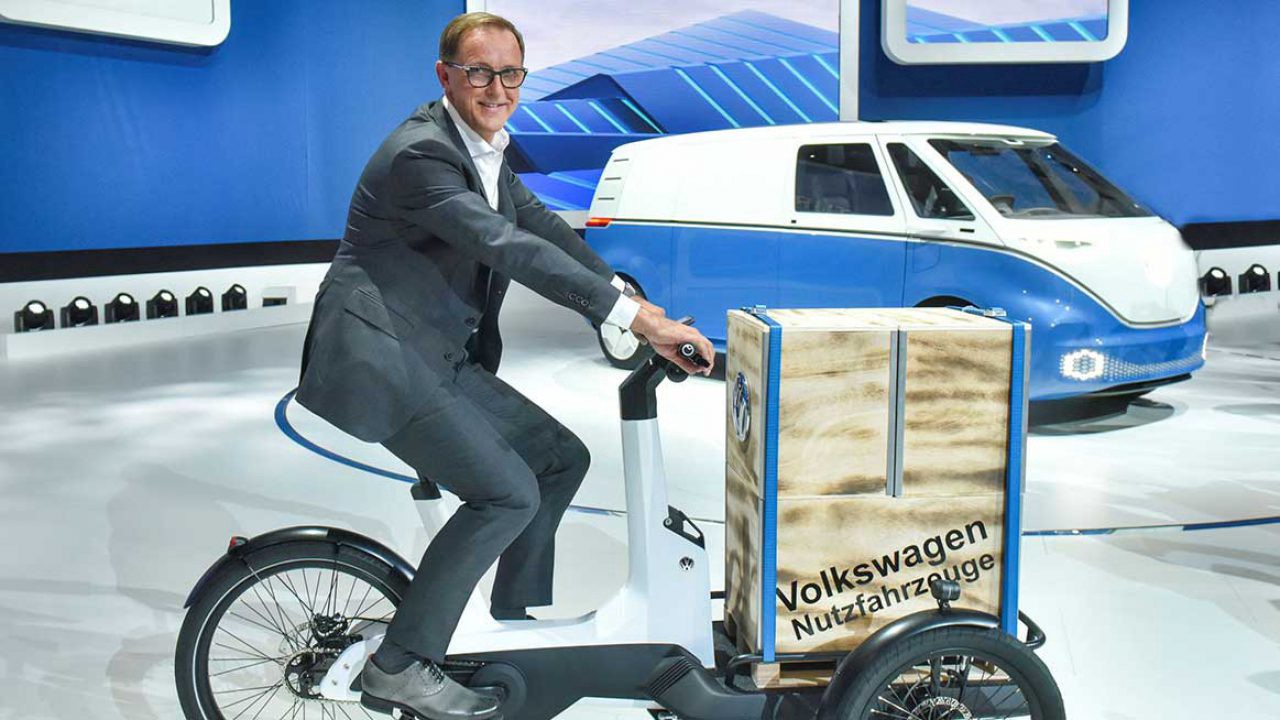
Just as the lowly bicycle is poised to take make share away from passenger cars in cities, the e-cargo bike is poised to displace zero-emissions vans in urban cores.

Just as the lowly bicycle is poised to take make share away from passenger cars in cities, the e-cargo bike is poised to displace zero-emissions vans in urban cores.

Many states, cities and the infamously car-centric Los Angeles are doing their part to work toward a clean transportation future. Now it’s time for Congress to put its foot on the accelerator of an EV.
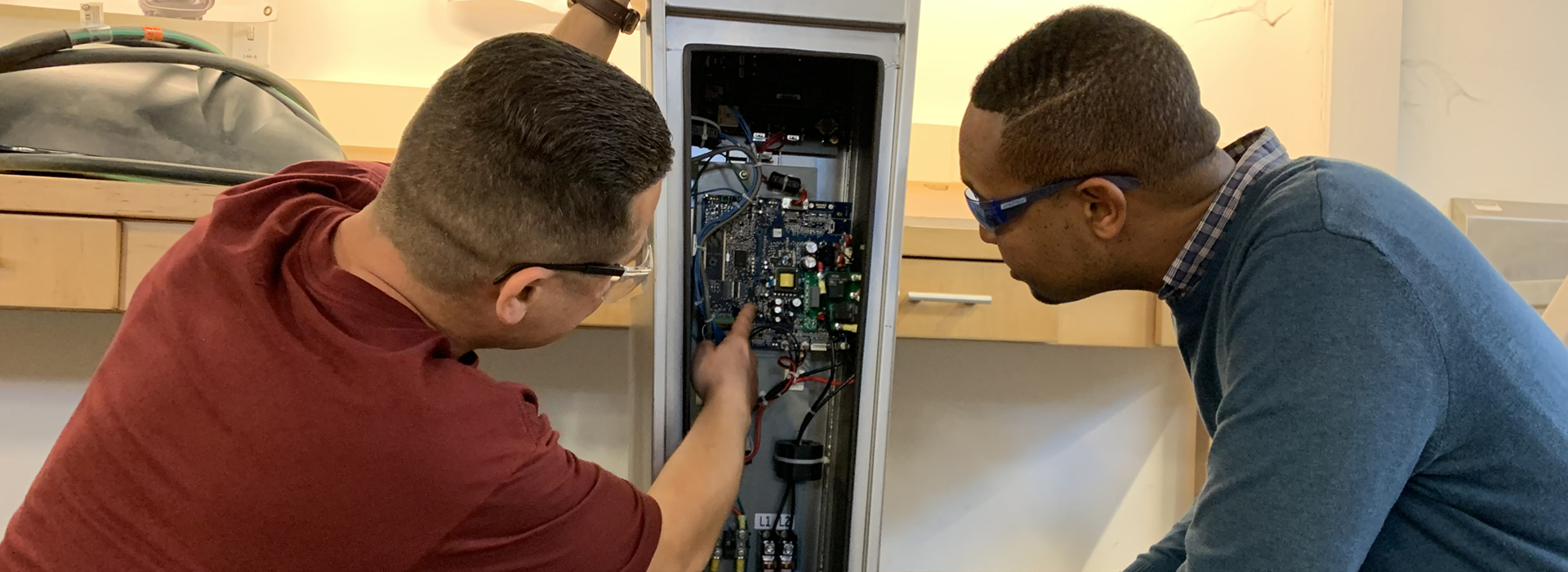
On a bright Thursday morning in February, students gathered around the slim EV charger as Jesse Montras gently opened the case, ran his hands over the cool metal and named off the parts—computer board, transformer, import block, GCF block. As the instructor and the other 29 students hung on his words, Jesse felt the people around him on edge, anticipating each word as he named part after part.
As he completed the quiz and the instructor moved on, Jesse thought back to how far he had come to be in the machine shop that day. In Jesse’s words, he “deviated from a young age”, and ended up incarcerated. He never thought he would graduate from high school, but while in prison he earned his GED and started working towards university credits in business at Palos Verdes college. After graduating from the APC Fellowship, Jesse plans to work to install EV charging stations and pursue his dream of building his own EVSE installation firm and grow with his own employees as the industry grows.
“My mentality has shifted,” said Jesse. “Once I got my GED I thought I would be satisfied to just get any job, but when this opportunity came up I realized that there was more for me—to better myself, leave a legacy, leave my past behind and move forward.”
Jesse is part of the Advanced Prototyping Center Fellowship Technical Boot Camp, a three-week training program where 30 students learn EVSE Light Repair and Troubleshoot Training—EV charging station repair and maintenance. When he graduates, Jesse will have earned industry-recognised skills including NFPA 70E Certification, EVSE Technical Knowledge and EVSE Industry On-Site Visits, plus benefitting from career coaching, teambuilding, effective communication courses and project-based learning.
Once he completes the three-week course, Jesse could be selected to join just 15 students who spend a further three months in the program and receive technical support from professional trainers. Cohort 1, which graduated in September 2019, 86% of participants were successfully placed at the end of the three-month Career Technical Support program.
The APC Fellowship Program is a multi-tiered workforce training pipeline program to provide promising candidates with technical training, interpersonal skills, and industry-recognized certifications to help them succeed. The program brings un- or under-employeed people from underrepresented groups an entree into the green economy with practical hands on training on EVSE Light Repair and Troubleshoot Training to support our Zero Emissions Mobility Pilot Program, which is part of the Transportation Electrification Partnership.
Through the APC Fellowship Program, students like Jesse can reach their potential and together we can ensure that everyone in Los Angeles can participate in and benefit from the green economy. Special thanks to our corporate partners the Bently Foundation, GoBiz, California Workforce Development Board and Wells Fargo, who support the APC Fellowship program.
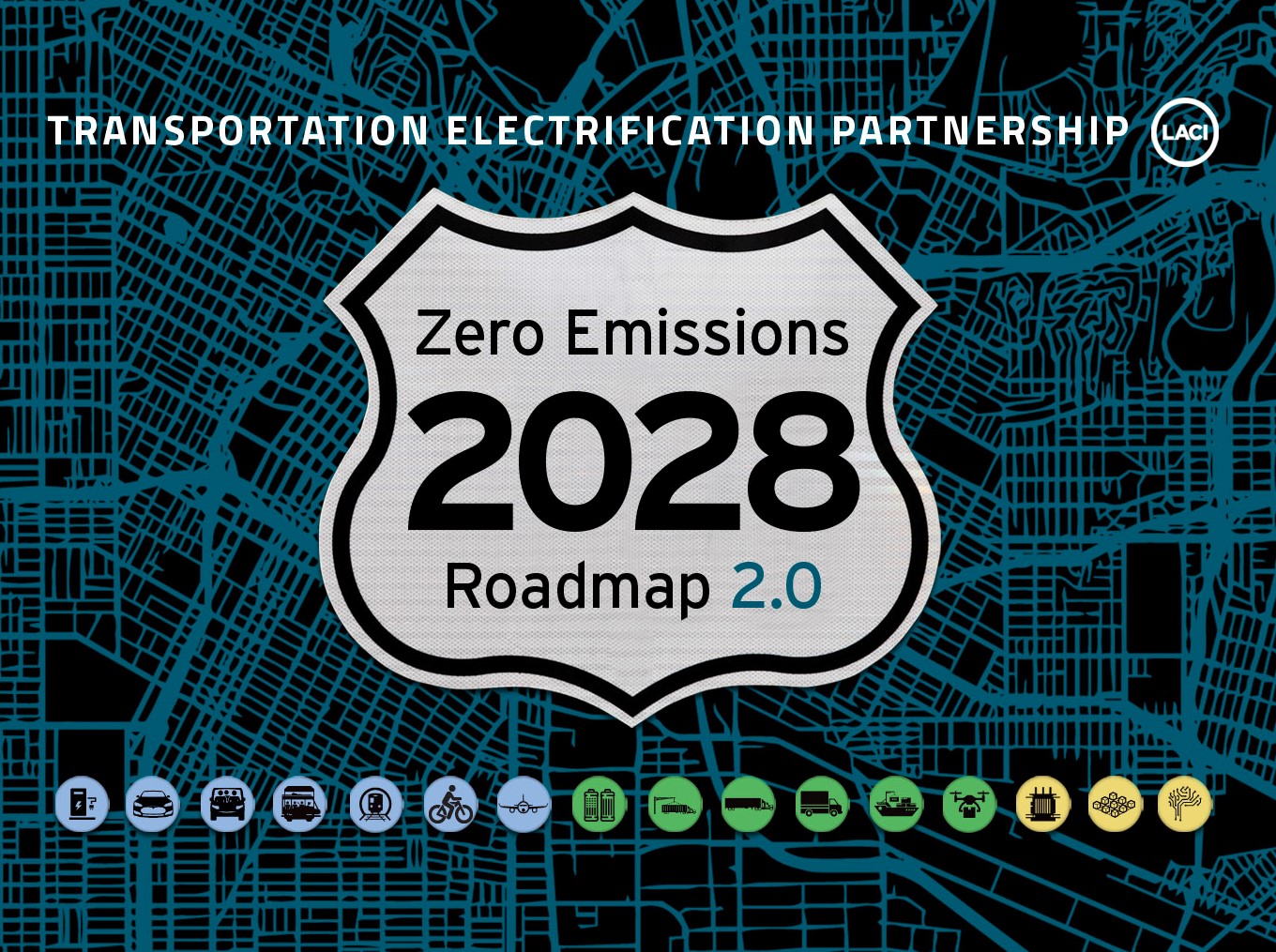
The Los Angeles Cleantech Incubator (LACI) and our Transportation Electrification Partnership members recently released the Zero Emissions 2028 Roadmap 2.0, an ambitious plan detailing the pathway we are working toward to create the zero emissions transportation future we want and need for the greater Los Angeles region. It’s a future that will result in cleaner air for residents and dramatically reduce the region’s transportation sector greenhouse gas emissions, reducing emissions an additional 25% beyond existing commitments tied to California state law. It’s a future that will take the integrated work of all the Partnership members and many other public and private sector allies, and we invite you to join us.
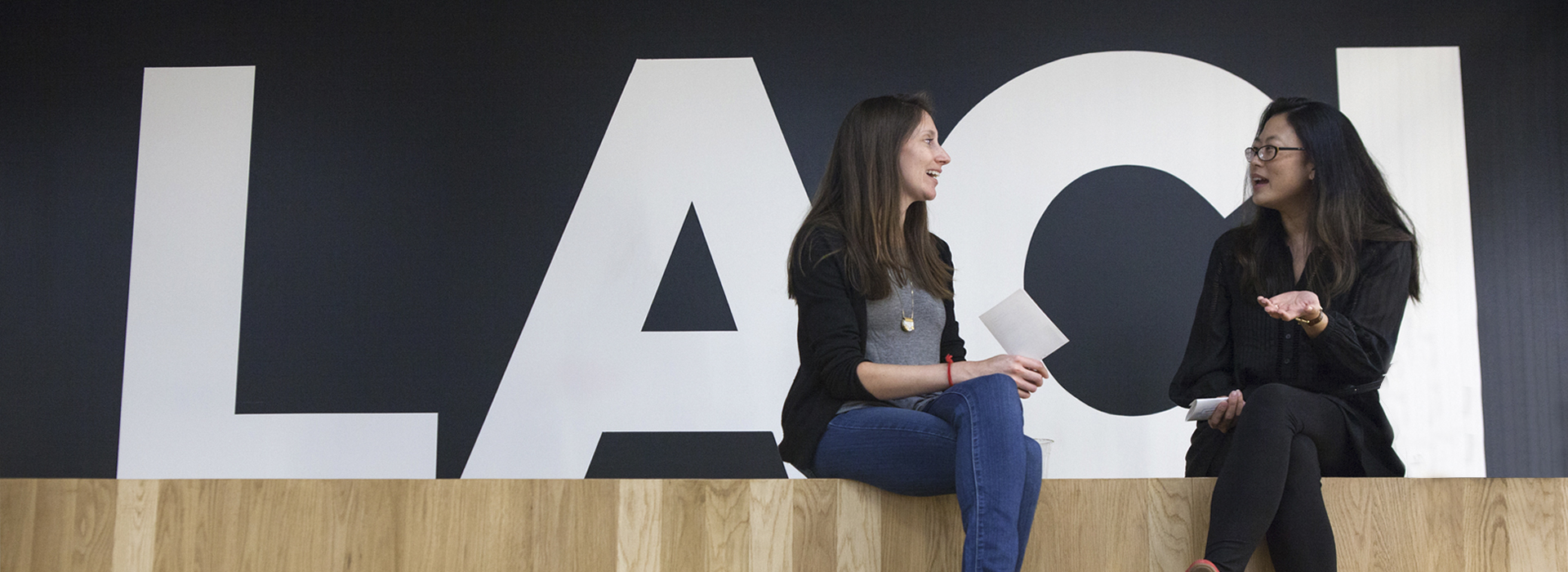
Los Angeles Cleantech Incubator Announces Creation of $5 Million Early-Stage Impact Investment Fund, Opens Call for Startups to Apply for New Cohort-Based Incubation Program
Impact Fund announces first two investments into LACI portfolio companies Seatrec and Freewire; Renewed startup incubation program offers $20,000 for pilot deployment, focuses on transportation electrification, clean energy, and circular economy
Los Angeles, January 15, 2020—The Los Angeles Cleantech Incubator (LACI) has launched a LACI Impact Fund for early-stage cleantech startups. As the Los Angeles-area continues to strengthen its position as a global leader in cleantech innovation and sustainability, the Fund will invest in a diverse slate of entrepreneurs ready to bring innovative and scalable cleantech technologies to market.
“The urgency of the climate crisis demands accelerated action – that’s why we are thrilled to announce the LACI Impact Fund, which will help scale innovation from startup entrepreneurs to help meet our region’s bold zero emissions transportation goals as well as solutions for clean energy and the circular economy,” said LACI President and CEO Matt Petersen. “As we relaunch our first cohort based startup program, the Fund provides a new tool to give our portfolio companies the opportunity for investment that aligns with their commitment to environmental, diversity and social impact.”
LACI’s first two investments in LACI portfolio companies Seatrec and FreeWire Technologies represent the organization’s commitment to accelerating the transportation electrification and 100 percent clean energy revolutions.
“Monitoring deep ocean areas with a device that uses no fuel is a key step in the fight against climate change,” said Seatrec Cofounder and CEO Dr. Yi Chao. “The LACI Impact Fund enabled Seatrec to scale and accelerate product development.”
“We’re enabling the rapid transition to zero emissions transportation revolution with ultrafast EV charging technology that also minimizes impacts on the grid,” said FreeWire Founder and CEO Arcady Sosinov. “The LACI Impact Fund is crucial because it will help us focus our social and environmental commitments as we scale.”
The $5 million LACI Impact Fund invests in LACI portfolio companies as a follow-on investor in active seed, Series A, and Series B rounds. LACI President and CEO Matt Petersen, California State Senate emeriti President pro Tempore Kevin de León (as a volunteer), and representatives from Emerson Collective, a social change organization, will lead the Fund’s Investment Committee.
The Fund considers a range of criteria when making investments, including:
Led by Emily Bjorkland Drake, SVP of Unlocking Innovation, LACI’s renewed, cohort based Incubation Program is now recruiting for Cohort 1. In addition to eligibility for the Fund, LACI startups also benefit from the partnership with City of LA and the Los Angeles Department of Water and Power through access to the world-class, 61,000 square foot La Kretz Innovation Campus (LKIC).
Participating startups will also benefit from:
The launch of the Fund comes as part of a breakthrough year for LACI which released of the Zero Emissions 2028 Roadmap in November 2019 with L.A. Mayor Eric Garcetti and others. The Roadmap is a result of the unprecedented Transportation Electrification Partnership led by LACI, City of Los Angeles Mayor Garcetti, County of Los Angeles, LADWP, SCE, CARB, & LA Metro, and includes private partners like Audi, BMW, Proterra, Amply (a LACI portfolio company). The Roadmap sets the nation’s most ambitious transportation electrification targets—to reduce greenhouse gas emissions and air pollution while addressing equity and growing the regional economy—by the time the world arrives in Greater Los Angeles for the 2028 Olympic and Paralympic Games.
In December 2019, LACI also announced the publication of the Cleantech Cities: Accelerating Climate Action Through Startups and Corporate Innovation report at the 2019 United Nations Climate Change Conference (COP25). The report, issued by LACI in partnership with C40 and with in-kind research and analysis from PwC, outlines the critical role collaboration between cities and cleantech entrepreneurs will play in accelerating climate action and securing a 1.5°C future for our planet. The reports recommendations shows that if followed, there is an opportunity to create a $5 trillion market while further reducing GHG emissions by another 35 percent.
About LACI
The Los Angeles Cleantech Incubator (LACI), a private nonprofit organization, is creating an inclusive green economy by unlocking innovation (through working with startups to accelerate the commercialization of clean technologies), transforming markets (through partnerships in transportation, energy and sustainable cities) and enhancing communities (through workforce development, pilots and other programs). Founded as an economic development initiative by the City of Los Angeles and its Department of Water & Power (LADWP), LACI is recognized as one of the most innovative business incubators in the world by UBI. In the past seven years, LACI has helped 108 portfolio companies raise $221M in funding, $220M in revenue, create 1,750 jobs, and deliver more than $393M in long term economic value. Learn more at laci.org
Media Contact:
Sunshine Sachs
424.362.9462
LACI@SuneshineSachs.com
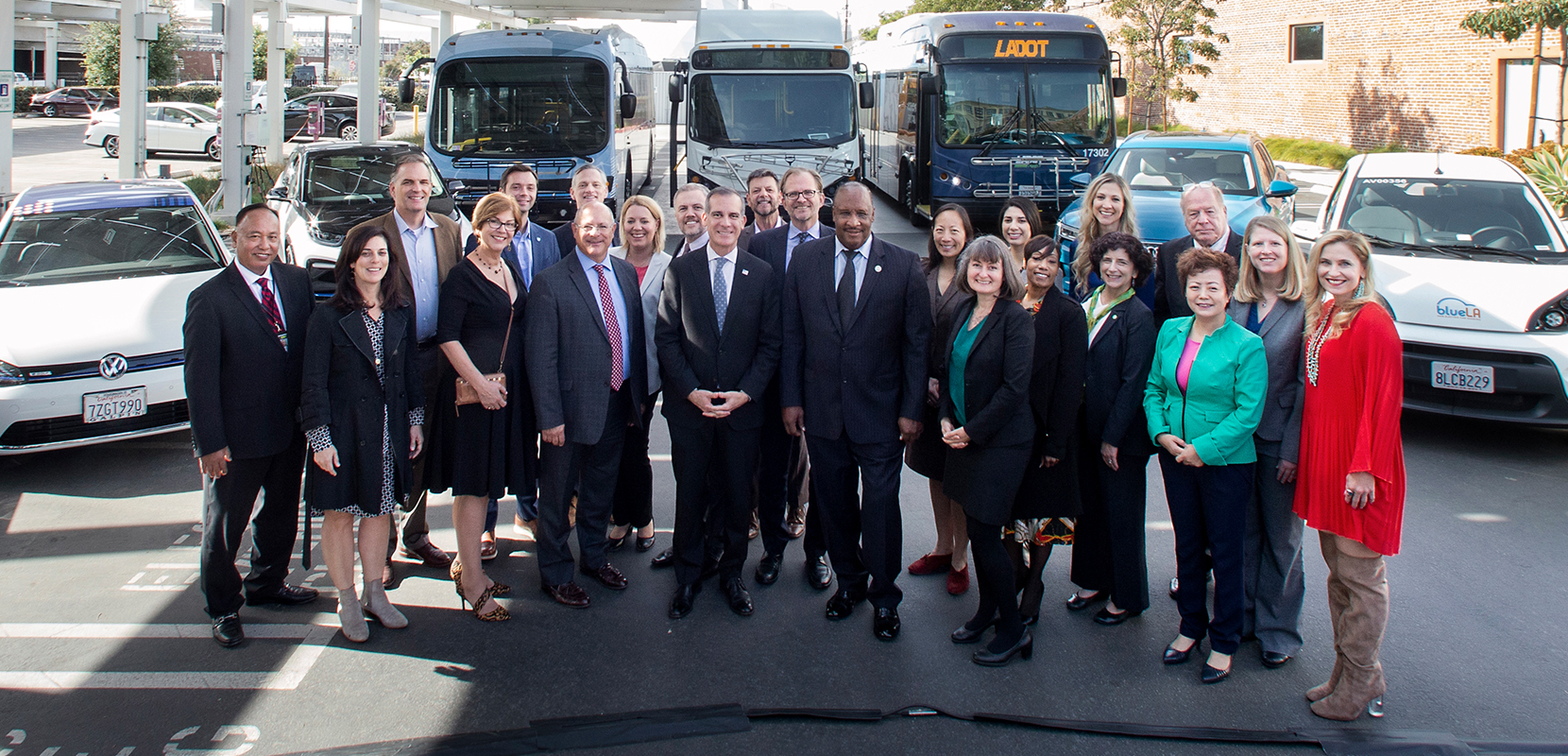
The Transportation Electrification Partnership commits to developing policies and pilots in 2020 to achieve bold new targets for EVs, charging infrastructure, mode shift and zero emissions trucks
LOS ANGELES, November 26, 2019 — The Los Angeles Cleantech Incubator (LACI) and its partners have released the Zero Emissions 2028 Roadmap 2.0, an ambitious plan to accelerate the deployment of zero-emissions electric cars, buses and trucks, and charging stations across the LA region. Achieving the roadmap’s targets and call to action will result in cleaner air for Los Angeles residents and dramatically reduce the region’s transportation sector greenhouse gas emissions, going 25 percent beyond existing commitments tied to California state law and the Paris Climate Accord.
“We can’t turn the tide on the climate crisis until we work across sectors and city limits to put the brakes on dangerous pollution and kick our zero emissions transportation future into high gear,” said Los Angeles Mayor Eric Garcetti. “Our Roadmap 2.0 charts a course toward a healthier region with a cleaner transit network — and draws up a blueprint for cities worldwide to follow, so all of us can invest in the smart policies and green energy that will strengthen our families’ well-being and quality of life for generations to come.”
The Roadmap 2.0 outlines exactly how this vision can become a reality for the LA region, embodying a strong commitment from public and private members of the Transportation Electrification Partnership (TEP). Together, the partners commit to work together in the coming year to develop policies, put in place pilots, and seek other strategies to achieve the targets in the Roadmap.
“The Zero Emissions 2028 Roadmap: 2.0 report doubles down on the bold steps we must take to accelerate clean air and climate action in Los Angeles and across the state,” says Chair of the California Air Resources Board (CARB) Mary D. Nichols. “Together, we can serve as a model for California, the nation, and the world by building a state of the art transportation system that moves people and goods cleanly, efficiently and sustainably throughout the region.”
“Clean air is a critical issue for all of us, especially the communities that have shouldered the burden of our transportation system and the harmful air pollution that it creates,” says Supervisor Janice Hahn, Los Angeles County Board of Supervisors. “The County of LA is proud to be in Leadership Group of the Transportation Electrification Partnership and I look forward to working with LACI and know that–with this 2028 Roadmap 2.0 as a guide–together we will forge the future of transportation for the health and welfare of all those in our communities.”
For the second edition of the Zero Emissions 2028 Roadmap, the TEP partners have committed to working individually and collectively towards the 25 percent goal through a three-pronged call to action to ensure:
“The bold targets we set together in the Zero Emissions Roadmap 2.0 are key to ensuring that we address the largest source of California’s GHGs and the region’s greatest source of air pollution: how we move ourselves and goods around the region,” stated Matt Petersen, LACI President and CEO. “The Transportation Electrification Partnership brings together the sectors we need to go further, faster together–we invite everyone to join us in achieving our ambitious targets and call to action.”
In all of this work, the TEP partners prioritize equity for disadvantaged communities that both lack access to last mile/first mile solutions as well as disproportionately suffer from health impacts, including asthma and heart attacks, associated with dirty, fossil-fueled transportation. In response, TEP and LACI recently announced mobility pilot projects and investment of $500,000 across four different disadvantaged communities across the LA region in neighborhoods that lack adequate mobility options— Pacoima, San Pedro, Long Beach and Huntington Park—with LACI startups to deliver EV car sharing and micromobility options.
The initiative was announced at La Kretz Innovation Campus in Downtown Los Angeles and the launch featured innovative technologies which will be integral to achieving the ambitious targets laid-out in the plan, including the Audi e-tron, BMW i3, Proterra Catalyst Battery Electric Bus, a BYD electric transit bus, Nissan New Mobility Concept (Twizy), an Envoy car-share vehicle, a BlueLA car-share vehicle, a Mobi EV Charger and a LADOT bus.
About TEP
The Transportation Electrification Partnership (TEP), formed by LACI in May 2018, is an unprecedented multi-year partnership among local, regional, and state stakeholders to accelerate progress towards transportation electrification and zero emissions goods movement in the Greater L.A. region in advance of the 2028 Olympic and Paralympic Games. TEP released the Zero Emissions 2028 Roadmap in September 2018 focusing on actions needed to achieve the shared goal of 25 percent additional reductions in GHGs and air pollution. The TEP Leadership Group includes the Mayor of L.A., County of Los Angeles, CARB, LADWP, SCE, Metro, and LACI.
About LACI
The Los Angeles Cleantech Incubator (LACI), a private nonprofit organization, is creating an inclusive green economy by unlocking innovation (through working with startups to accelerate the commercialization of clean technologies), transforming markets (through partnerships in transportation, energy and sustainable cities) and enhancing communities (through workforce development, pilots and other programs). Founded as an economic development initiative by the City of Los Angeles and its Department of Water & Power (LADWP), LACI is recognized as one of the most innovative business incubators in the world by UBI. In the past seven years, LACI has helped 78 portfolio companies raise $221M in funding, $220M in revenue, create 1,750 jobs, and deliver more than $393M in long term economic value. Learn more at laci.org
Contact
Sarah Bryce
424.362.9462
sarah@laci.org

The Los Angeles Cleantech Incubator will deploy up to $500,000 in investments, grants and technical assistance for zero emissions technology pilots in San Pedro, Pacoima, Long Beach and Huntington Park
Los Angeles, November 12, 2019. The Los Angeles Cleantech Incubator (LACI) announced the recipients of the Zero Emissions Mobility and Community Pilot Project Fund today. LACI will work with community partners including community based organizations and technology providers in San Pedro, Pacoima, Long Beach and Huntington Park to scope, build, operate and provide ongoing maintenance and technical assistance for zero emissions mobility pilot projects costing up to $100,000 in each community.
The community partners and projects are:
“While zero emissions first/last mile solutions are being deployed across the region, they are often not being deployed equitably to underserved communities that need them most,” says Matt Petersen, CEO of LACI. “Zero emission mobility pilot projects are a key element of LACI’s Transportation Electrification Partnership and will help bring the benefits of the green economy to neighborhoods that may lack zero emissions mobility, yet are burdened with poor air quality from various sources. The path to a zero emissions future includes addressing community needs as well as key technology, business model and educational challenges.”
“For too long families in Pacoima have suffered from the burdens of pollution and poor air quality that cause too many missed school days and trips to the emergency room,” says Veronica Padilla, Executive Director of Pacoima Beautiful. “Zero emissions transportation solutions exist today to help solve these problems and our community is poised to take advantage of them. We can’t wait to begin developing and deploying our EV car share program with our partners at LACI.”
“My kids are growing up in San Pedro, which is just one of the many reasons I am committed to action to ensure clean air,” says Joe Buscaino, Council Member from the 15th District. Los Angeles must create the infrastructure for zero emissions transportation and public transit to ease traffic congestion and reduce greenhouse gas emissions—and all communities must be engaged. I commend LACI for spearheading these pilots as a first step.”
“Offering zero emissions transportation solutions at our public housing in San Pedro can provide a low-cost, reliable and efficient solution for our residents who don’t have access to their own vehicles,” says Jenny Scanlin, Chief Development Officer of HACLA. “Offering an on-demand EV transportation option is also a game-changer for a community greatly impacted by historical environmental pollutants.”
“Families in Huntington Park and neighboring cities at the front-line of pollution deserve to benefit from the innovative solutions of the emerging clean green economy,” says Bahram Fazeli, Director of Research and Policy, Communities for a Better Environment. “Setting up a zero emissions mobility hub and charging stations in partnership with LACI will help our community test and pilot creative solutions that can be replicated across the city—and enhance clean mobility access throughout southeast LA communities.”
“Fighting climate change through zero-emission policies has to be part of the strategy for building strong and healthy communities,” said Mayor Robert Garcia, City of Long Beach. “These efforts must build on the work we are doing at our ports under the 2017 Clean Air Action Plan Update.”
“With the development of our Lower Los Angeles River (LLAR) resource center, our participants will provide river stewardship services from South Gate to the Port of Long Beach,” says Dan Knapp, Executive Director and CEO, Conservation Corps of Long Beach. “Deploying zero emissions first/last mile solutions with LACI as part of our workforce development project gets us ahead and will help us lead in transportation electrification while serving our corps members and their communities.”
“Protecting and improving the quality of life for all LA County residents means protecting and improving the air we breathe, and I applaud the community organizations working to deploy these zero emissions pilot projects,” says Assemblymember Miguel Santiago, California’s 53rd Assembly District. “Thanks to the leadership of LACI, working together we can embrace zero emissions technology and give voice to residents who have been burdened by air pollution for too long.”
The Zero Emissions Mobility and Community Pilot Project Fund was announced by Mayor Garcetti in May 2019 to help meet the goals of LA’s Green New Deal by delivering creative solutions to cut air pollution and greenhouse gas emissions, spur innovation and make good on the commitment to environmental justice in every community.
Piloting zero emissions mobility solutions that help meet the needs of disadvantaged communities while reducing air pollution is key to meeting the targets in the Transportation Electrification Partnership 2028 Roadmap 2.0—to be released on November 26th—which sets ambitious regional goals for passenger electric vehicles, mode shift and infrastructure investments. The Transportation Electrification Partnership is an unprecedented multi-year partnership among local, regional and state stakeholders to accelerate transportation electrification and zero emissions goods movement in the Greater LA region by 2028.
About LACI
The Los Angeles Cleantech Incubator (LACI), a private nonprofit organization, is creating an inclusive green economy by unlocking innovation (through working with startups to accelerate the commercialization of clean technologies), transforming markets (through partnerships in transportation, energy and sustainable cities) and enhancing communities (through workforce development, pilots and other programs). Founded as an economic development initiative by the City of Los Angeles and its Department of Water & Power (LADWP), LACI is recognized as one of the most innovative business incubators in the world by UBI. In the past seven years, LACI has helped 78 portfolio companies raise $221M in funding, $220M in revenue, create 1,750 jobs, and deliver more than $393M in long term economic value. Learn more at laci.org
Contact
Sarah Bryce
424.362.9462
sarah@laci.org
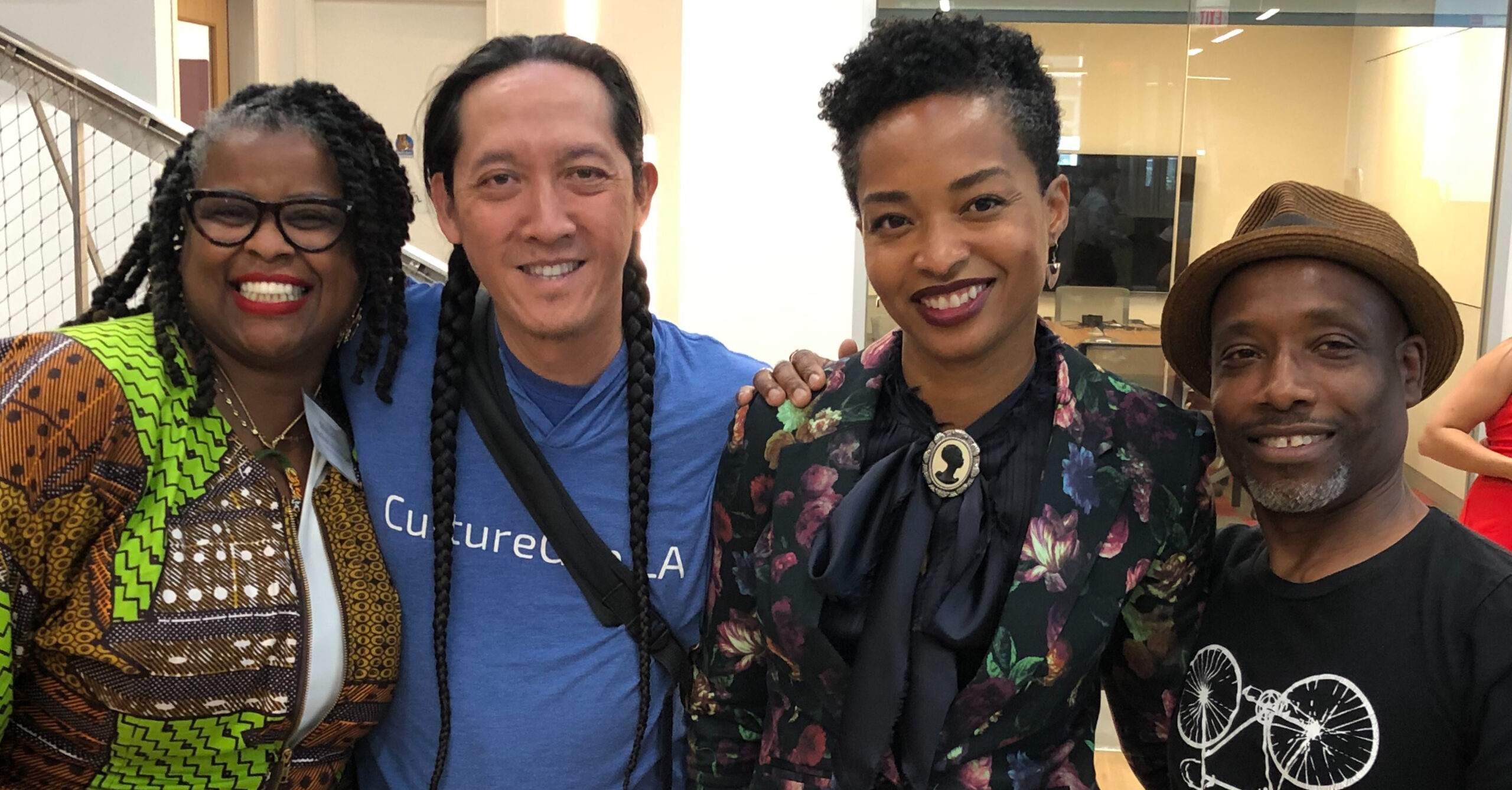
Just a few months ago, the Los Angeles Cleantech Incubator (LACI) and Mayor Eric Garcetti introduced the first 13 participants in Cohort 1 of the Founders Business Accelerator (FBA) program. Today, we celebrate the successful completion of the program for our inaugural business participants and the launch of the application process for our Cohort 2 2020 program.
The FBA is a small business and startup acceleration program designed to assist underrepresented small business and startup founders in low income neighborhoods in the City of Los Angeles grow their businesses. The FBA program recognizes the potential of small business owners and gives them the tools they need to succeed and grow their enterprises.
Prompted by the Mayor’s Office of Economic Development and the strong support of Council Members Marqueece Harris-Dawson and Monica Rodriguez, the FBA program is part of a city-wide initiative for cultivating a more equitable economy for all Angelenos. “Small businesses are the beating heart of our economy—job creators that share Los Angeles’ innovative spirit with the world,” said Mayor Garcetti regarding the FBA program. “Working together with LACI, we’re ensuring small business owners have the tools they need to reach new markets, grow their bottom-line and thrive.”
The long-term goal of the FBA program is to create a collaborative innovation center for small business owners and facilitate future generations of change agents dedicated to making a positive economic and social and environmental impact here in Los Angeles.
FBA participant NanaEfua Afoh-Manin is the CEO of Shared Harvest Fund. Shared Harvest is the first student loan repayment benefit and rewards program that is mobile and available for independent workers. Nana shared that “the most valuable part of the FBA program was definitely the cohort, the family of people that would support what you’re doing and validate that yes, you are the person to get it done. The way I see my business making an impact in Los Angeles to significantly lower the number of student loan debt overall compared to most of the major cities. The real problem right now in Los Angeles when we’re talking about equity in an urban sector is that African American women still have the largest percentage of student loan debt. And we’re also the ones that are most impactful in volunteering and social enterprises. So this is an opportunity to take the shackles off and allow us to dream big and recreate what we want last time just to look like without that.”
LACI’s FBA program is helping Nana and the other 12 dynamic business leaders selected in Cohort 1 by providing invaluable mentorship as well as legal, human resources and marketing consulting services. Each cohort member was paired with a seasoned business mentor to help refine goal setting, manage finances and provide successful growth strategies.
Do you or someone you know have a small business that is dedicated to making social economic or environmental impact in their community? Applications for the Cohort 2 2020 FBA Program are currently being accepted.
Learn more about the FBA program, Cohort 1 or to apply for Cohort 2.
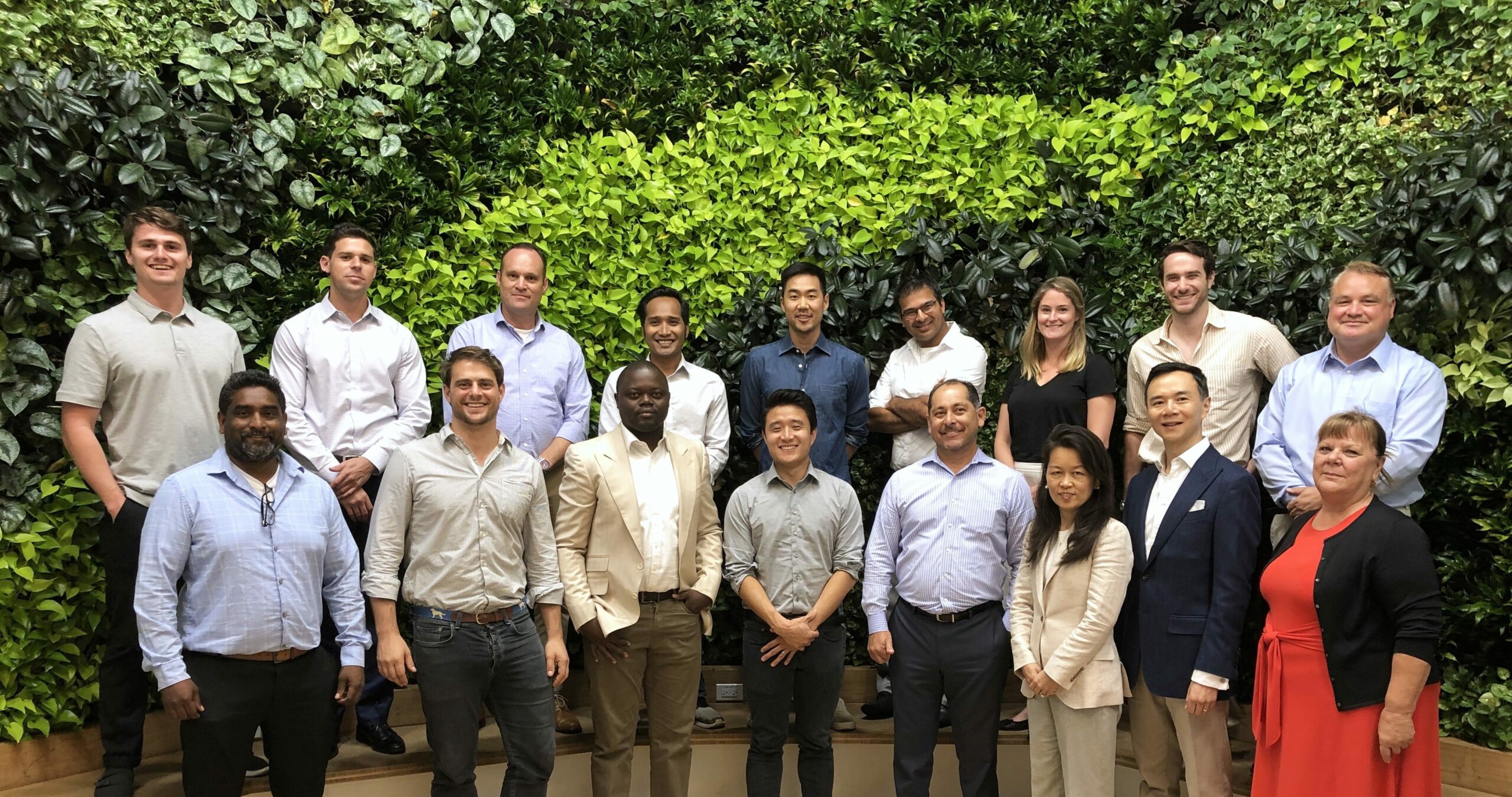
We just selected our fourth cohort of LACI Innovators and we chose 18 exciting companies to spend one year with us. We are inspired by these dynamic and dedicated founders—many from diverse backgrounds—who are revolutionizing clean energy and the energy-transportation nexus and tackling the climate crisis head-on. Throughout the recruitment process, getting to know the companies and meeting with founders, we saw an interesting trend that we think spells good news for cleantech overall.
We saw that the cleantech innovation ecosystem in California is growing, thanks in large part to the dedication of the California Energy Commission (CEC), which has funded programs to nurture cleantech like the LACI Innovators Program over the past several years. This year we received 41 applications for the Innovators Program, and accepted 18 companies into the cohort. This is almost more than the past three cohorts combined! We saw an increase in the number, stage and quality in clean energy companies in the region since we began recruiting in 2017. Additionally, this year 27% of the applicants were referrals from partner organizations, programs or funds, further showing that a distinct innovation ecosystem has developed in Southern California.
Many of the startups in this cohort work with our network partners, from the CEC, Caltech’s Rocket Fund, CalSEED, other universities and Cleantech Open West. Grants from the CEC are helpful for nascent startups, like Green Light Labs, who has a pilot with LA County employees to personalize car shopping by recording trips and then computing the fuel consumption, costs and charging needs if those trips had been in an EV. Caltech’s FLOW Rocket Fund also supports the ecosystem, and several startups in our new cohort are recipients, such as NeoCharge, which offers a 220 volt splitter plus software for home renters and saves thousands of dollars in energy costs and and enables grid flexibility for utility companies (NeoCharge was also a California Climate Cup semi-finalist!). Many of the startups selected for this cohort also received funding from CalSEED, such as Pronoia, Luminescent Energy, Radii Robotics, SolarFlexes.
We found that this growing ecosystem is particularly distinct in Southern California, in part because Southern California has some of the most dynamic utilities which are exploring new programs and investing in transportation electrification and clean energy. For example, SCE’s Clean Power and Electrification Pathway bold vision and LADWP’s announcement not to replace three gas-fired power plants in the region and instead replace them with renewable energy sources and storage send clear signals to the market that there is opportunity for innovation. This is part of the reason that Green Light Labs, a software platform to accelerate EV adoption, and SolPad, a battery with microgrid capabilities for solar, both Cohort 4 Innovators, have relocated to Southern California from Northern California.
The full cohort is listed below:
Alacharge
Alacharge is an auto-lock charging station for electric scooters to serve as a charge point as well as pick-up located at private parking structure and lots. Stations will cut charging costs for the scooter companies, an added source of revenue for property owners, and provide a scooter management solution for cities.
Camus is building a three pronged cloud system to orchestrate distributed grid resources; deploying the first two products – situational awareness/real-time analytics- $300k /year and orchestration platform/optimization engine first; smaller vendors (CCAs) then to utilities; eventually will incorporate marketplace aspect and reach out to ISOs; will partner with device aggregators like Chargepoint and Nest.
CrossnoKaye retrofits existing HVAC-R systems and enables them to dynamically modify their load profile in response to grid needs. They create algorithms and models for HVAC-R processes and shift energy around peak pricing. This balances the system’s efficiency with grid needs to both reduce and reshape building loads.
Through current pilot projects, their system has proved a two year ROI and typically saved between 25-40% on initial electricity bill with increased savings over time.
Drought Diet Products turns irrigation into a grid management asset through AI. The system’s AI responds to overcapacity on the grid from renewable energy generation by pulling short intervals of power to power irrigation system. Their overall goal is to smooth grid load during the day through powering irrigation.
Currently, they are testing their energy concept and working with multiple universities on developing the technology. Because a part of the product, the irrigation component, is tested and manufactured, they are focusing on the energy aspect of their final product.
Eve Energy Ventures is a smart charging scheduling platform that allows drivers to find and reserve a shared charger in offices and apartments. The platform also is optimized to provide key benefits for the property owners through increased revenue and reduced costs.
Their technology is an app sold to property managers or owners to enroll existing charging infrastructure. In pilots to date, they have seen EV drivers gain twice the number of opportunities to charge, leading to benefits for the owners of the chargers. Currently, they are selling systems to multi-unit dwellings. Through a partnership with Schneider Electric they have established pilot systems to feedback on their beta platform for further development.
Software platforms to accelerate EV adoption. MyGreenCar app personalizes car shopping. It automatically records trips in your current car, then computes the fuel consumption, costs, or EV range viability and charging needs if those trips were made in any vehicle you’re considering to buy. MyFleetBuy solution provides analytics for greening and electrification of fleets who are purchasing hundreds of vehicles at a time. It identifies the cost savings, range viability, and charging needs to deploy EVs across entire fleets.
Jump Watts is developing a mobile charging solution for electric bikes and scooters. Through their three unique products, a trailer, van and bicycle unit, Scooter Chargers can lease Jump Watts products to charge LEVs on-the-go.
They are currently in product development of two products: the trailer and van concepts. The trailer prototype is finishing testing and will be close to an MVP by Q4 – they hope to launch a final product at the beginning of 2020. The van prototype is still early in its prototyping phase.
Lilypad Energy is currently building a method of relaying curtailment requests from aggregators through a software that simplifies the enrollment and operation of EVs, home batteries, and other IoT. Lilypad Energy can streamline the enroll of ‘assets’ into DR / GS ‘programs’, and monitor curtailment by reading an asset’s energy consumption. In doing so, they are looking at building infrastructure for a microgrid in the Santa Barbara region.
Currently, Lilypad is working on their beta product through development of the equipment facing API and the API for scheduling coordinators/grid service providers. They have two pilots currently deployed in Santa Barbara.
Luminescent Energy
Luminescent Energy is developing power-generating windows featuring both power generation and thermal energy management. It uses micro-solar cells embedded into the window technology while maintaining high visual acuity and quality. The main value of this technology is a 5% higher power conversion efficiency of other luminescent devices while remaining cost competitive and reliable over time.
The technology was developed at Caltech through an ARPA-e grant. The team is now finishing durability and lifetime testing while concurrently building out their business and market strategy.
NeoCharge has developed a 220 volt splitter that provides easy EV charging access at home. It is a solution for both home renters and owners, and enables grid flexibility. The technology includes software with smart functionality that allows owners to save money and use clean energy from the grid.
With 31 units sold through early adopter channels, NeoCharge is engaged in getting their UL certification and tracking current deployed units for product development.
Open Source Strategies’s “Opentaps SEAS Platform” monitors the energy assets of a property to centralize all data connected to the status of energy equipment and infrastructure. Based on an open source software developed by the DOE for smart grid and building efficiency, this cloud-based software integrates the data to optimize the energy efficiency of a building and calculate the real-time value of that energy. This creates a data stream to securitize energy efficiency projects and renewable energy investment. It’s like a home equity loan for installed equipment.
Currently, Open Source Strategies has a large pilot project with a major East Coast municipality to enroll 60 buildings onto their software. With this pilot they are working on algorithms to tag and analyze the data.
Pronoia is developing a new type of battery that utilizes a proprietary Quantum-Dipole technology. This innovation has a 10-100x increase in energy density compared to existing storage technologies. Given the high density, they predict their system will have the lowest kWh price worldwide.
The technology has been in development by Dr. Wooyong Lie for over 15 years. Currently, they are 8 months away from their prototype and are expanding their team to finish the R&D.
Radii Robotics has designed a drone robot to inspect wind turbines with game changing hardware and software components.
The team is currently building upon their foundational platform and looking to test and pilot in Q2/Q3 of 2020.
Ranier Solar Panel is developing a proprietary bifacial solar panel on a proprietary mount and frame. They predict that their unique configuration can offer 20% more power per ft² than traditional panels by producing power longer in the day. The main value proposition offered by their technology is a higher power output over time therefore lowering the lifetime cost.
They are currently deep in R&D to develop a final technology through a partnership with ASU’s Solar Power Lab. Ranier plans on developing 10 prototype units at the APC to test at the ASU facility.
The SolarFlexes rapidly-installed PV array is a ground-mounted system that delivers cost-savings through process innovation to reduce all inputs for ground-mounted PV array installations. The majority of the system’s manufacturing value is added in a factory setting where lean, six-sigma processes maximize manufacturing efficiency and quality control while ensuring the system’s structural integrity and durability. The prefabricated array is transported to the project site in sections using standard shipping containers and rapidly installed using only a car/truck, trailer, and hand tools.
Currently, SolarFlexes is finalizing the CAD designs and looking for funding to begin engineering and testing. The team is interested in using the APC for prototyping efforts.
SolPad provides solar storage and management solutions, Renewable Solar + Storage + Intelligent Management, for small scale home and commercial energy systems. Their cloud application and mobile app control system allows it to function on and off the grid.
By selling through residential installers and developers, SolPad seeks to provide cost-effective and flexible power alternatives to people living in expensive power regions around the world. This mission has led to a $61M PO in Puerto Rico through the largest solar developer in the area.
Currently, SolPad is finishing up UL certification and expect to complete it by Q4. Once UL is in place, they will install pilots in Palo Alto then deploy in Puerto Rico.
Substance Power & Mobility seeks to build industrial-grad, lithium-ion based, energy storage hardware pieces to be deployed interchangeable between buildings and fleets. Their “hardware ecosystem” deploys the components through creating modular lego-like batteries for both stationary and mobile applications.
The goal for the technology is to create a comprehensive sustainable energy solution for industrial facility & fleet operations. Currently, they are in very early stages of CAD design and look at continuing product development until Q3 of 2021.
TBM Designs has invented the Invert Self-Shading Window installments using smart thermobimetal. By installing their product inside the cavity of a standard Insulated Glass Unit (IGU), it can dynamically reduce heat gain at the surface of the building envelope, thereby reducing air-conditioning by over 15%, while maintaining light quality. Invert Windows operate autonomously and don’t require any power; it “uses no energy to save energy”.
The innovation was developed by an architecture professor at USC. Through partnering with window manufacturers, they see their product to have the biggest impact on large scale buildings with large window surface.
Currently, they are in the final stages of product development, and are now shifting towards a final commercial product development.

Originally published on ACT News
How to Curb Emissions From Trucking
Did you know that the greatest single source of air pollution in Los Angeles comes from the trucks, trains, and ships that bring goods in and out of our Ports of Los Angeles and Long Beach, that 40% of all the goods that come into the US come from these ports, and that one out of every six jobs in the region is related to goods movement?
Answering the question of how we get more zero emission trucks on our freeways to lower greenhouse gas (GHG) emissions and clean the air is particularly important for the Los Angeles region. The unintended consequence of this economic activity is hurting communities living near the ports and along the freeways that are disproportionately affected by poor air quality. At the same time, the goods movement industry is vital to the region’s economy and represents a large portion of vehicles on the road. Medium- and heavy-duty trucks comprise the second largest categories of GHG emissions in the transportation sector and goods movement represents the region’s largest source of air pollution.
Lowering GHG emissions and air pollution from goods movement is a key focus of the Transportation Electrification Partnership—an unprecedented multi-year partnership among local, regional, and state stakeholders, convened by LACI, to accelerate progress towards transportation electrification and zero emission goods movement in the Greater Los Angeles region in advance of the 2028 Olympic and Paralympic Games.
In 2018 the partnership developed its first 2028 Zero Emissions (ZE) Roadmap, which set goals for regional transportation electrification and statewide ZE goods movement—goals like 25-50% of all medium-duty delivery trucks in LA County to be electric, and 10-40% of heavy-duty regional drayage truck to be ZE, all by 2028.
Where Are We and Where Do We Need to Go
To understand where we are with ZE goods movement, from the manufacturers making ZE trucks, the trucking companies buying them and utilities and charging infrastructure companies installing chargers, LACI first needed to level set on the state of the complex needs of the whole goods movement ecosystem.
Together with the California Air Resources Board (CARB), the Ports of Los Angeles and Long Beach, and the California Energy Commission (CEC), LACI issued a Request for Information (RFI), asking medium- and heavy-duty truck manufacturers, EV supply equipment manufacturers, EV charging station networks, fleet operators, and fleet charging companies about their ZE goods movement plans, in order to:
What We Learned
LACI received 39 responses from a wide variety of companies including multinational corporations that have led the industry for decades as well as California-based startups innovating from the ground up.
We learned that:
Where Do We Go From Here? A Seamless Corridor Approach
Based on the findings, LACI and the Transportation Electrification Partnership members recommend a holistic approach to accelerating ZE medium- and heavy-duty trucks and infrastructure. The partners suggest a pilot framework to establish heavy-duty drayage routes supported by medium-duty distribution hubs serving as both cargo points and charging stations. Additional charging options would be established at third-party logistics yards, truck stops and/or via mobile zero emissions charging solutions, adding up to a seamless electrified corridor along the lower I-710 freeway and providing truck operators with the confidence needed to invest in zero emissions solutions.
Given the market share of goods traveling along the 710 freeway, concentrating investment in this type of comprehensive pilot would not only enable the Los Angeles region to meet its ZE goods movement goals, but could serve as the linchpin to transitioning the regional movement of goods at ports and cities across the country. LACI is working now to identify funding for this pilot project from a number of potential sources.
In September 2019, LACI will announce the 2028 Zero Emissions (ZE) Roadmap 2.0, with revised target ranges for goods movement by the time the world arrives in Los Angeles for the 2028 Olympic and Paralympic Games.
Good to Know: Other ZE Transportation Pilot Projects
In addition to the potential pilot project for goods movement along the lower 710 freeway, LACI and the Transportation Electrification Partnership are working on a last-mile solution—the Zero Emissions Mobility and Community Pilot Project Fund—to ensure that every community benefits from the green economy, and neighborhoods that are disproportionately affected by poor air quality can work to clean the air around them. The path to a ZE future means addressing community needs as well as key technology, business model, and educational challenges. Pilot projects as part of the ZE Mobility and Community Pilot Project Fund will be deployed in late 2019 and developed hand-in-hand with selected disadvantaged communities. Lessons from these projects will be shared and used to inform new projects and policy recommendations going forward.